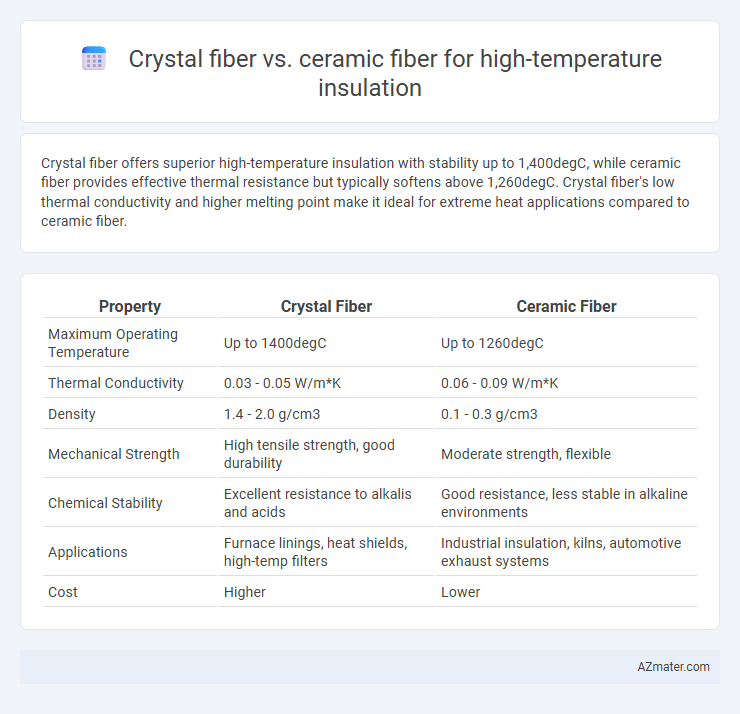Crystal fiber offers superior high-temperature insulation with stability up to 1,400degC, while ceramic fiber provides effective thermal resistance but typically softens above 1,260degC. Crystal fiber's low thermal conductivity and higher melting point make it ideal for extreme heat applications compared to ceramic fiber.
Table of Comparison
| Property | Crystal Fiber | Ceramic Fiber |
|---|---|---|
| Maximum Operating Temperature | Up to 1400degC | Up to 1260degC |
| Thermal Conductivity | 0.03 - 0.05 W/m*K | 0.06 - 0.09 W/m*K |
| Density | 1.4 - 2.0 g/cm3 | 0.1 - 0.3 g/cm3 |
| Mechanical Strength | High tensile strength, good durability | Moderate strength, flexible |
| Chemical Stability | Excellent resistance to alkalis and acids | Good resistance, less stable in alkaline environments |
| Applications | Furnace linings, heat shields, high-temp filters | Industrial insulation, kilns, automotive exhaust systems |
| Cost | Higher | Lower |
Introduction to High Temperature Insulation Materials
High temperature insulation materials such as crystal fiber and ceramic fiber are essential for thermal management in industrial applications exceeding 1000degC. Crystal fiber, primarily composed of aluminum silicate, offers superior tensile strength and thermal stability, making it ideal for environments requiring mechanical durability and chemical resistance. Ceramic fiber, made from alumina-silica blends, excels in low thermal conductivity and high temperature resistance, providing efficient insulation in furnaces, kilns, and heat treatment processes.
Overview: What Are Crystal Fibers?
Crystal fibers, also known as alumina-based fibers, are high-purity, continuous fibers primarily composed of alumina or alumina-silica with exceptional thermal stability above 1200degC (2192degF). These fibers exhibit superior resistance to chemical corrosion, high mechanical strength, and low thermal conductivity, making them ideal for high-temperature insulation in extreme industrial applications. Compared to ceramic fibers, crystal fibers offer enhanced durability, maintaining structural integrity and insulation performance under prolonged exposure to intense heat and aggressive environments.
Overview: What Are Ceramic Fibers?
Ceramic fibers are inorganic, non-metallic fibers composed primarily of alumina and silica, engineered for high-temperature insulation applications up to 1,260degC (2,300degF). These fibers provide excellent thermal stability, low thermal conductivity, and resistance to chemical corrosion, making them ideal for furnaces, kilns, and other industrial equipment. Unlike crystal fibers, ceramic fibers offer superior flexibility and thermal shock resistance, enhancing durability in fluctuating thermal environments.
Key Physical Properties: Crystal vs Ceramic Fiber
Crystal fiber exhibits superior tensile strength and higher melting points, typically exceeding 1725degC, while ceramic fiber offers excellent thermal stability up to around 1260degC. Crystal fiber's low thermal conductivity and high modulus make it ideal for extreme high-temperature insulation applications, whereas ceramic fiber provides better flexibility and lower density, contributing to easier installation and handling. Both fibers possess low thermal expansion, but crystal fiber maintains structural integrity under prolonged exposure to ultra-high temperatures better than ceramic fiber.
Thermal Performance Comparison
Crystal fiber exhibits superior thermal performance compared to ceramic fiber, maintaining stability at temperatures up to 1800degC due to its high melting point and low thermal conductivity. Ceramic fiber typically withstands temperatures up to 1400degC but shows higher thermal conductivity, resulting in less effective insulation at extreme heat. The enhanced thermal resistance of crystal fiber makes it ideal for applications requiring minimal heat loss and prolonged durability under intense thermal stress.
Mechanical Strength and Durability
Crystal fiber exhibits superior mechanical strength and high temperature resistance compared to ceramic fiber, making it ideal for demanding thermal insulation applications. Its enhanced durability under thermal cycling and mechanical stress ensures prolonged service life in extreme environments. Ceramic fiber, while effective at insulation, tends to degrade faster under mechanical strain and high temperature fluctuations, limiting its durability.
Chemical Resistance and Stability
Crystal fiber offers superior chemical resistance compared to ceramic fiber, maintaining stability in highly acidic and alkaline environments at temperatures exceeding 1200degC. Ceramic fiber provides excellent thermal insulation but tends to degrade faster under aggressive chemical exposure due to its amorphous silica-alumina composition. For prolonged high-temperature applications requiring robust chemical stability, crystal fiber is the preferred material due to its crystalline alumina-silica matrix and resistance to corrosive agents.
Cost Efficiency and Availability
Crystal fiber insulation offers superior high-temperature resistance up to 1800degC and excellent thermal stability but comes at a higher cost due to complex manufacturing processes and limited production scale. Ceramic fiber provides effective insulation up to 1260-1430degC with greater cost efficiency and wider availability, making it a preferred choice for large-scale industrial applications where budget constraints are critical. Availability of ceramic fiber is higher due to established manufacturing infrastructure, while crystal fiber remains niche, impacting overall cost-effectiveness for heat insulation projects.
Common Applications in Industry
Crystal fiber and ceramic fiber are widely used for high-temperature insulation in industrial applications such as furnace linings, kilns, and thermal processing equipment. Crystal fiber, known for its high melting point and excellent thermal stability, is preferred in aerospace, petrochemical, and glass manufacturing industries where extreme heat resistance is critical. Ceramic fiber, favored for its lightweight and cost-effective properties, is commonly utilized in power plants, steel mills, and automotive exhaust systems to provide efficient thermal insulation and energy conservation.
Choosing the Best Fiber for High Temperature Insulation
Crystal fiber offers superior thermal stability and resistance to molten metal penetration, making it ideal for applications exceeding 1400degC. Ceramic fiber provides excellent insulating properties and flexibility at temperatures up to 1200degC, but may degrade faster under prolonged high-temperature exposure. Selecting between crystal and ceramic fiber depends on the specific temperature range, mechanical durability, and chemical resistance required for the insulation environment.

Infographic: Crystal fiber vs Ceramic fiber for High temperature insulation
 azmater.com
azmater.com